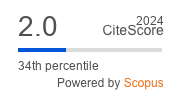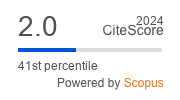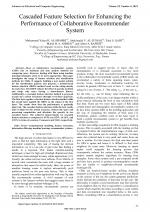| 4/2018 - 3 |
Cascaded Feature Selection for Enhancing the Performance of Collaborative Recommender SystemAL-SHAMRI, M. Y. H. |
| Extra paper information in |
| Click to see author's profile in |
| Download PDF |
Author keywords
computational modeling, feature extraction, information filtering, machine learning, recommender systems
References keywords
systems(18), recommender(16), learning(9), machine(8), data(8), collaborative(7), system(6), selection(6), recommendation(6), filtering(6)
Blue keywords are present in both the references section and the paper title.
About this article
Date of Publication: 2018-11-30
Volume 18, Issue 4, Year 2018, On page(s): 23 - 34
ISSN: 1582-7445, e-ISSN: 1844-7600
Digital Object Identifier: 10.4316/AECE.2018.04003
Web of Science Accession Number: 000451843400003
SCOPUS ID: 85058813839
Abstract
Most of collaborative recommender systems (CRSs) rely on statistical and data analysis methods for comparing users. However, dealing with them using machine learning techniques seems to be more appropriate. This paper investigates the usage of feature selection and classification methods for CRSs. It suggests building a user model suitable for the classification purpose and proposes a density-based feature selection (DBFS) method based on the rating density for each class. The DBFS reduces the effect of sparsity problem and keeps only users having a dense-feature history. Additionally, a cascaded feature selection method is proposed to pick out a subset of features through a two-layer approach. The first layer applies a classical feature selection method while the second layer applied the DBFS on the output of the first layer. The results show that the performance is gradually improved. The cascaded feature selection yields the best results since it improves the system accuracy, reduces the space and processing complexities, and alleviates the sparsity in two cascaded layers. The achieved improvements by cascaded feature selection as compared to SVM are 6.55 percent, 10.14 percent, and 3.92 percent in terms of accuracy, F-measure and MAE, respectively. |
| References | | | Cited By «-- Click to see who has cited this paper |
| [1] D. Donoho, "High-dimensional data analysis: the curses and blessings of dimensionality," in Proc. American Mathematical Society Conference of Math Challenges of the 21st Century, 2000.
[2] I. Portugal, P. Alencar, and D. Cowan, "The use of machine learning algorithms in recommender systems: a systematic review," arXiv, vol. 4, pp. 1-16, Nov. 2015. [CrossRef] [3] J. Bobadilla, F. Ortega, A. Hernando, and A. Gutierrez, "Recommender systems survey," Knowledge-Based Systems, vol. 46, pp.109-132, 2013. [CrossRef] [SCOPUS Times Cited 2713] [4] M. D. Ekstrand, J. T. Riedl, and J. A. Konstan, "Collaborative filtering recommender systems," Foundations and Trends in Human-Computer Interaction, vol. 4, No. 2, pp. 81-173 2010. [CrossRef] [SCOPUS Times Cited 870] [5] F. Isinkaye, Y. Folajimi, and B.Ojokoh, "Recommendation systems: Principles, methods and evaluation," Egyptian Informatics Journal, vol. 16, pp. 261-273, 2015. [CrossRef] [SCOPUS Times Cited 1094] [6] X. Su and T. M. Khoshgoftaar, "A survey of collaborative filtering techniques," Advances in Artificial Intelligence, vol. 2009, pp. 1-9, 2009. [CrossRef] [7] M. Y. H. Al-Shamri, "User profiling approaches for demographic recommender systems," Knowledge-Based Systems, vol. 100, pp. 175-187, 2016. [CrossRef] [SCOPUS Times Cited 138] [8] R. Burke, "Hybrid recommender systems: Survey and experiments," User Modeling and User-Adapted Interaction, vol. 12, No. 4, pp. 331-370, 2002. [CrossRef] [SCOPUS Times Cited 3168] [9] J. S. Breese, D. Heckerman, and C. Kadie, "Empirical analysis of predictive algorithms for collaborative filtering," in Proc. 14th conference on Uncertainty in artificial intelligence, 1998, pp. 43-52. [10] I. Guyon, S. Gunn, M. Nikravesh, and L. Zadeh, Feature Extraction: Foundations and Applications. Springer, pp. 463-470, 2006. [CrossRef] [11] L. Yu and H. Liu, "Efficient feature selection via analysis of relevance and redundancy", Journal of Machine Learning Research, vol. 5, pp. 1205-1224, 2004. [12] V. B. Canedo, "Novel feature selection methods for high dimensional data," PhD thesis, March 2014. [13] C. Basu, H. Harish, W. Cohen, "Recommendation as classification: Using social and content-based information in recommendation," AAAI Technical Report, WS-98-08, 1998. [14] L. Schmidt-Thieme, "Compound classification models for recommender systems," in Proc. 5th IEEE International Conference on Data Mining, 2005, pp. 378-385. [CrossRef] [SCOPUS Times Cited 18] [15] K. Wang, Y. Tan, "A new collaborative filtering recommendation approach based on naive Bayesian method," in: Tan Y., Shi Y., Chai Y., Wang G. (eds) Advances in Swarm Intelligence. ICSI 2011. Lecture Notes in Computer Science, Springer, Berlin, Heidelberg, vol. 6729, pp. 218-227, 2011. [CrossRef] [16] K. Miyahara and M. J. Pazzani, "Improvement of collaborative filtering with the simple Bayesian classifier," IPSJ journal, vol. 43, no. 11, pp. 3429-3437, 2002. [17] D. Bouneffouf, A. Bouzeghoub, and A. L. Gançarski, "Hybrid- ?-greedy for mobile context-aware recommender system," in Proc. Pacific-Asia Conference on Knowledge Discovery and Data Mining, Springer Berlin Heidelberg, 2012, pp. 468-479. [CrossRef] [SCOPUS Times Cited 21] [18] A. I. Saleh, A. I. El Desouky, and S. H. Ali, "Promoting the performance of vertical recommendation systems by applying new classification techniques," Knowledge-Based Systems, vol. 75, pp. 192-223, 2015. [CrossRef] [SCOPUS Times Cited 26] [19] B. Wang, Q. Liao, and C. Zhang, "Weight based KNN recommender system," in Proc. 5th International Conference on Intelligent Human-Machine Systems and Cybernetics (IHMSC), 26-27 August 2013, pp. 449-452. [CrossRef] [SCOPUS Times Cited 23] [20] A. Bouza, G. Reif, A. Bernstein, and H. Gall, "SemTree: ontology-based decision tree algorithm for recommender systems," in Proc. Semantic Web Conference, Karlsruhe, Germany, 2008. [21] Y. Cho, J. Kim, and S. Kim, "A personalized recommender system based on web usage mining and decision tree induction," Expert Systems with Application, vol. 23, No, 2, pp. 329-342, 2002. [CrossRef] [SCOPUS Times Cited 376] [22] D. Nikovski and V. Kulev, "Induction of compact decision trees for personalized recommendation," in Proc. ACM Symposium on Applied Computing, Dijon, France, April 2006, pp. 575-581. [CrossRef] [SCOPUS Times Cited 23] [23] W. Cheng, J. Hühn, and E. Hüllermeier. "Decision tree and instance-based learning for label ranking," in Proc. 26th Annual International Conference on Machine Learning (ICML 09), New York, NY, USA, 2009, pp. 161-168. [CrossRef] [SCOPUS Times Cited 24] [24] X. Su and T. M. Khoshgoftaar, "Collaborative filtering for multi-class data using belief nets algorithms," International Journal on Artificial Intelligence Tools, vol. 17, No. 1, pp. 71-85, 2008. [CrossRef] [SCOPUS Times Cited 23] [25] T. Zhang and V. S. Iyengar, "Recommender systems using linear classifiers," Journal of Machine Learning Research, vol. 2, pp. 313-334, 2002. [26] A Gershman, A. Meisels, K-H. Luke, L. Rokach, A. Schclar, and A. Sturm, "A decision tree based recommender system," in Proc. 10th Conf. on Innovative Internet Community Services, Trondheim, Norway, 2010, pp. 170-179. [27] T. Zhang and F. Ma, "Improved rough k-means clustering algorithm based on weighted distance measure with Gaussian function", International Journal of Computer Mathematics, vol. 94, no. 4, pp. 663-675, 2017. [CrossRef] [SCOPUS Times Cited 59] [28] I. D. Borlea, R. E. Precup, F. Dragan and A. B. Borlea, "Centroid update approach to k-means clustering", Advances in Electrical and Computer Engineering, vol. 17, no. 4, pp. 3-10, 2017. [CrossRef] [Full Text] [SCOPUS Times Cited 44] [29] S. Chakraborty and S. Das, "k-means clustering with a new divergence-based distance metric: Convergence and performance analysis", Pattern Recognition Letters, vol. 100, pp. 67-73, 2017. [CrossRef] [SCOPUS Times Cited 56] [30] S. Zahra, M. A. Ghazanfar, A. Khalid, M. A. Azam, U. Naeem, A. P. Bennett, "Novel Centroid Selection Approaches for K-Means Clustering Based Recommender Systems", Information Sciences, Vol. 320, pp. 156-189, Nov. 2015. [CrossRef] [SCOPUS Times Cited 206] [31] S. Sharma, "A Recommender System Based on Improvised K- Means Clustering Algorithm", International Journal of Research in Advent Technology, Vol. 6, No. 7, pp. 1477-1483, July 2018. [32] J. Bobadilla, R. Bojorque, A. H. Esteban, and R. Hurtado, "Recommender Systems Clustering Using Bayesian Non Negative Matrix Factorization", IEEE Access, Vol. 6, pp. 3549-3564, 2018. [CrossRef] [SCOPUS Times Cited 65] [33] C. C. Aggarwal, Data Mining: The Textbook, Springer, pp. 285-343, 2015. [CrossRef] [SCOPUS Times Cited 942] [34] S. Yu, Z-H Zhou, M. Steinbach, D. J. Hand, and D. Steinberg, "Top 10 algorithms in data mining," Knowledge Information Systems, vol. 14, pp. 1-37, 2008. [CrossRef] [SCOPUS Times Cited 4514] [35] T. K. Ho, "Random decision forests," in Proc.3rd International Conference on Document Analysis and Recognition, Montreal, QC, 14-16 August 1995, pp. 278-282. [CrossRef] [SCOPUS Times Cited 6175] [36] C. Cortes, and V. Vapnik, "Support-vector networks," Machine Learning, vol. 20, pp. 273-297, 1995. [CrossRef] [37] I. Guyon, and A. Elisseeff, "An introduction to variable and feature selection," Journal of Machine Learning Research, vol. 3, pp. 1157-1182, 2003. [38] V. Bolón-Canedo, N. Sanchez-Marono, and A. Alonso-Betanzos, Feature Selection for High-Dimensional Data, Springer, pp. 31-40, 2015. [39] G. Chandrashekar, and F. Sahin, "A survey on feature selection methods," Computers and Electrical Engineering, vol. 40, pp. 16-28, 2014. [CrossRef] [SCOPUS Times Cited 4116] [40] M. Y. H. Al-Shamri, Effect of Collaborative Recommender System Parameters: Common Set Cardinality and the Similarity Measure, Advances in Artificial Intelligence 2016 (2016), 10 pages [41] A. Al-Junaid, T. Qaid, MYH Al-Shamri, M. Ahmed, A Raweh, Vertical and Horizontal DNA Differential Methylation Analysis for Predicting Breast Cancer, IEEE Access, vol. 6, pp. 53533-53545, 2018. [CrossRef] [SCOPUS Times Cited 6] [42] N. Japkowicz and M. Shah, Evaluating learning algorithms: a classification perspective, Cambridge, pp. 74-159, 2011. [CrossRef] [SCOPUS Times Cited 957] [43] A. Zhang, Evaluating Machine Learning Models: A Beginner Guide to Key Concepts and Pitfalls, O'Reilly Media, pp. 7-12, 2015. Web of Science® Citations for all references: 0 SCOPUS® Citations for all references: 25,657 TCR Web of Science® Average Citations per reference: 0 SCOPUS® Average Citations per reference: 583 ACR TCR = Total Citations for References / ACR = Average Citations per Reference We introduced in 2010 - for the first time in scientific publishing, the term "References Weight", as a quantitative indication of the quality ... Read more Citations for references updated on 2025-07-01 00:27 in 192 seconds. Note1: Web of Science® is a registered trademark of Clarivate Analytics. Note2: SCOPUS® is a registered trademark of Elsevier B.V. Disclaimer: All queries to the respective databases were made by using the DOI record of every reference (where available). Due to technical problems beyond our control, the information is not always accurate. Please use the CrossRef link to visit the respective publisher site. |
Faculty of Electrical Engineering and Computer Science
Stefan cel Mare University of Suceava, Romania
All rights reserved: Advances in Electrical and Computer Engineering is a registered trademark of the Stefan cel Mare University of Suceava. No part of this publication may be reproduced, stored in a retrieval system, photocopied, recorded or archived, without the written permission from the Editor. When authors submit their papers for publication, they agree that the copyright for their article be transferred to the Faculty of Electrical Engineering and Computer Science, Stefan cel Mare University of Suceava, Romania, if and only if the articles are accepted for publication. The copyright covers the exclusive rights to reproduce and distribute the article, including reprints and translations.
Permission for other use: The copyright owner's consent does not extend to copying for general distribution, for promotion, for creating new works, or for resale. Specific written permission must be obtained from the Editor for such copying. Direct linking to files hosted on this website is strictly prohibited.
Disclaimer: Whilst every effort is made by the publishers and editorial board to see that no inaccurate or misleading data, opinions or statements appear in this journal, they wish to make it clear that all information and opinions formulated in the articles, as well as linguistic accuracy, are the sole responsibility of the author.



